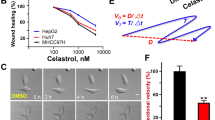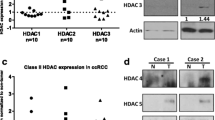Abstract
Cell migration plays major roles in human renal cancer-related death, but the molecular mechanisms remain unclear. Valproic acid (VPA) is a broad-spectrum inhibitor of class I and II histone deacetylases and shows great anticancer activity in a variety of human cancers. In this study, we found that VPA significantly inhibited cell migration but not proliferation of human renal cancer ACHN cells. Mechanistic studies found that VPA significantly inhibited the expression of HIF-1α. Knockdown of HIF-1α could obviously inhibited cell migration, while over-expression of HIF-1α markedly rescued the inhibition of VPA on cell migration. Further studies found that knockdown of HDAC2 completely mimicked the effects of VPA on HIF-1α and cell migration, and over-expression of HIF-1α could also rescue the effects of HDAC2 knockdown on cell migration. Collectively, these results indicated that the potential of specific inhibition of HDAC2 by small molecular chemicals may lead to future therapeutic agents in human renal cancer treatment.




Similar content being viewed by others
Abbreviations
- RCC:
-
Renal cell carcinoma
- ccRCC:
-
Clear cell renal cell carcinoma
- VPA:
-
Valproic acid
- PCR:
-
Polymerase chain reaction
- 786-O:
-
Cultivated cells of human renal cell cancer
- ACHN:
-
Human kidney adenocarcinoma cell line
- HDAC:
-
Histone deacetylase
- HIF-1α:
-
Hypoxia-inducible factor-1 alpha
References
Ji C, Li X, Zhang S et al (2011) Laparoscopic radiofrequency ablation of renal tumors: 32-month mean follow-up results of 106 patients. Urology 77(4):798–802
Iacovelli R, Lanoy E, Albiges L, Escudier B (2012) Tumour burden is an independent prognostic factor in metastatic renal cell carcinoma. BJU Int 110(11):1747–1753
Vanharanta S, Shu W, Brenet F et al (2013) Epigenetic expansion of VHL-HIF signal output drives multiorgan metastasis in renal cancer. Nat Med 19(1):50–56
Giannini G, Cabri W, Fattorusso C, Rodriquez M (2012) Histone deacetylase inhibitors in the treatment of cancer: overview and perspectives. Future Med Chem 4(11):1439–1460
Dallavalle S, Pisano C, Zunino F et al (2012) Development and therapeutic impact of HDAC6-selective inhibitors. Biochem Pharmacol 84(6):756–765
Berendsen S, Broekman M, Seute T et al (2012) Valproic acid for the treatment of malignant gliomas: review of the preclinical rationale and published clinical results. Expert Opin Investig Drugs 21(9):1391–1415
Cotto M, Cabanillas F, Tirado M et al (2010) Epigenetic therapy of lymphoma using histone deacetylase inhibitors. Clin Transl Oncol 12(6):401–409
Sermeus A, Michiels C (2011) Reciprocal influence of the p53 and the hypoxic pathways. Cell Death Dis 2:e164
Iqbal MM, Sohhan T, Mahmud SZ (2001) The effects of lithium, valproic acid, and carbamazepine during pregnancy and lactation. J Toxicol Clin Toxicol 39(4):381–392
Chen N, Chen LP, Zhang J et al (2012) Molecular characterization and expression analysis of three hypoxia-inducible factor alpha subunits, HIF-1α/2α/3α of the hypoxia-sensitive freshwater species, Chinese sucker. Gene 498(1):81–90
Schito L, Rey S, Tafani M et al (2012) Hypoxia-inducible factor 1-dependent expression of platelet-derived growth factor B promotes lymphatic metastasis of hypoxic breast cancer cells. Proc Natl Acad Sci USA 109(40):E2707–E2716
Richon VM (2010) Targeting histone deacetylases: development of vorinostat for the treatment of cancer. Epigenomics 2(3):457–465
Wang G, He J, Zhao J et al (2012) Class I and class II histone deacetylases are potential therapeutic targets for treating pancreatic cancer. PLoS One 7(12):e52095
McCormack E, Haaland I, Venås G et al (2012) Synergistic induction of p53 mediated apoptosis by valproic acid and nutlin-3 in acute myeloid leukemia. Leukemia 26(5):910–917
Mamlouk S, Wielockx B (2012) Hypoxia-inducible factors as key regulators of tumor inflammation. Int J Cancer. doi:10.1002/ijc.27901
Edeline J, Rioux-Leclercq N (2008) Renal cell carcinoma and prognostic factors. Ann Pathol 28(5):374–380
Singh BN, Zhang G, Hwa YL et al (2010) Nonhistone protein acetylation as cancer therapy targets. Expert Rev Anticancer Ther 10(6):935–954
Menegola E, Cappelletti G, Di Renzo F (2012) Epigenetic approaches and methods in developmental toxicology: role of HDAC inhibition in teratogenic events. Methods Mol Biol 889:373–383
Seuter S, Heikkinen S, Carlberg C (2013) Chromatin acetylation at transcription start sites and vitamin D receptor binding regions relates to effects of 1α,25-dihydroxyvitamin D3 and histone deacetylase inhibitors on gene expression. Nucleic Acids Res 41(1):110–124
Verheul HM, Salumbides B, Van Erp K et al (2008) Combination strategy targeting the hypoxia inducible factor-1 alpha with mammalian target of rapamycin and histone deacetylase inhibitors. Clin Cancer Res 14(11):3589–3597
Geng H, Harvey CT, Pittsenbarger J et al (2011) HDAC4 protein regulates HIF1α protein lysine acetylation and cancer cell response to hypoxia. J Biol Chem 286(44):38095–38102
Xu Y, Li Y, Li H et al (2013) The accumulations of HIF-1α and HIF-2α by JNK and ERK are involved in biphasic effects induced by different levels of arsenite in human bronchial epithelial cells. Toxicol Appl Pharmacol 266(2):187–197
Qian DZ, Kachhap SK, Collis SJ et al (2006) Class II histone deacetylases are associated with VHL-independent regulation of hypoxia-inducible factor 1 alpha. Cancer Res 66(17):8814–8821
Kim MJ, Kim DE, Jeong IG et al (2012) HDAC inhibitors synergize antiproliferative effect of sorafenib in renal cell carcinoma cells. Anticancer Res 32(8):3161–3168
Oddsson SJ, Hardarson S, Petursdottir V et al (2012) Synchronous pulmonary metastases from renal cell carcinoma—a whole nation study on prevalence and potential resectability. Scand J Surg 101(3):160–165
Acknowledgments
This work was partially supported by grants from the National Natural Science Foundation of China (Nos. 81270831 and 81000311).
Conflict of interest
The authors declared no potential conflicts of interests with respect to the authorship and/or publication of this article.
Author information
Authors and Affiliations
Corresponding author
Additional information
Feng-qiang Yang, Min Liu and Feng-ping Yang have contributed equally to this work.
Rights and permissions
About this article
Cite this article
Yang, Fq., Liu, M., Yang, Fp. et al. VPA inhibits renal cancer cell migration by targeting HDAC2 and down-regulating HIF-1α. Mol Biol Rep 41, 1511–1518 (2014). https://doi.org/10.1007/s11033-013-2996-2
Received:
Accepted:
Published:
Issue Date:
DOI: https://doi.org/10.1007/s11033-013-2996-2




